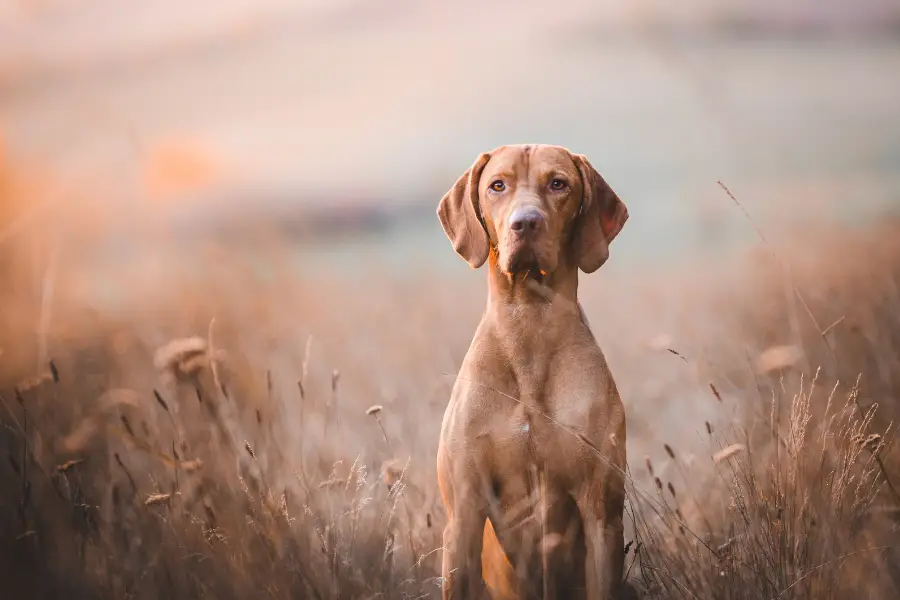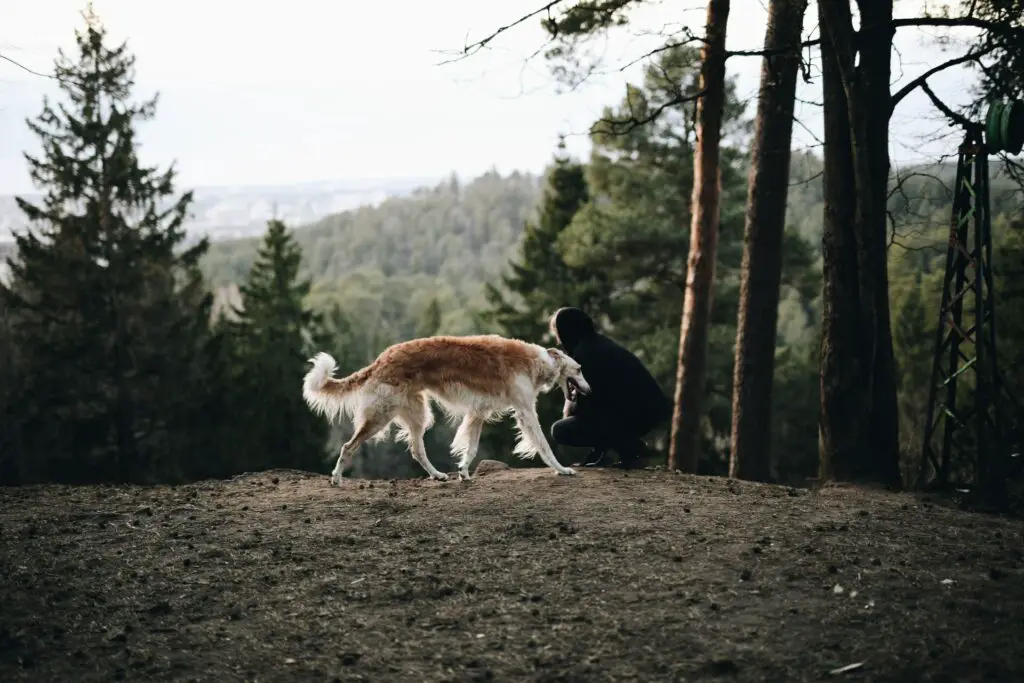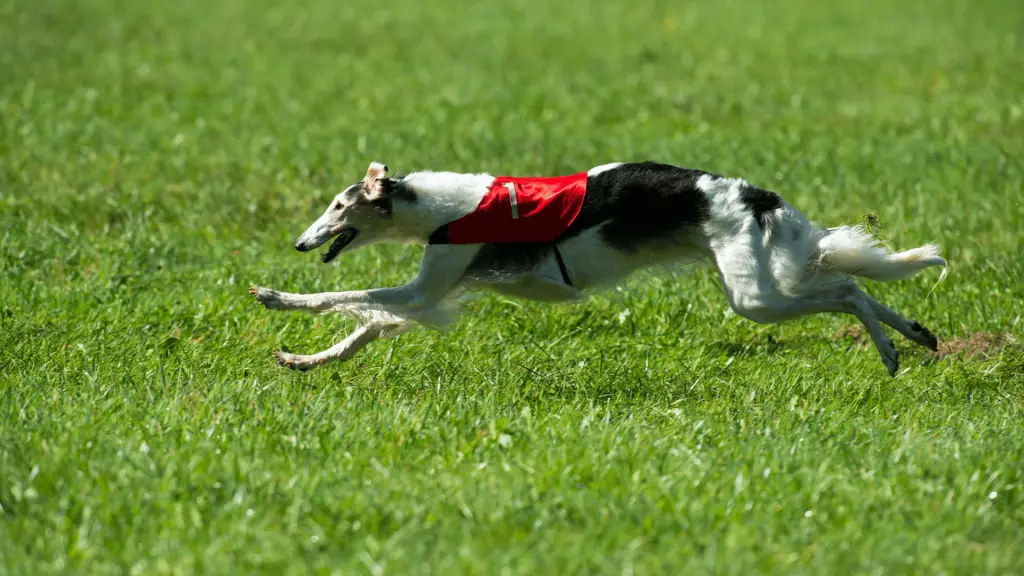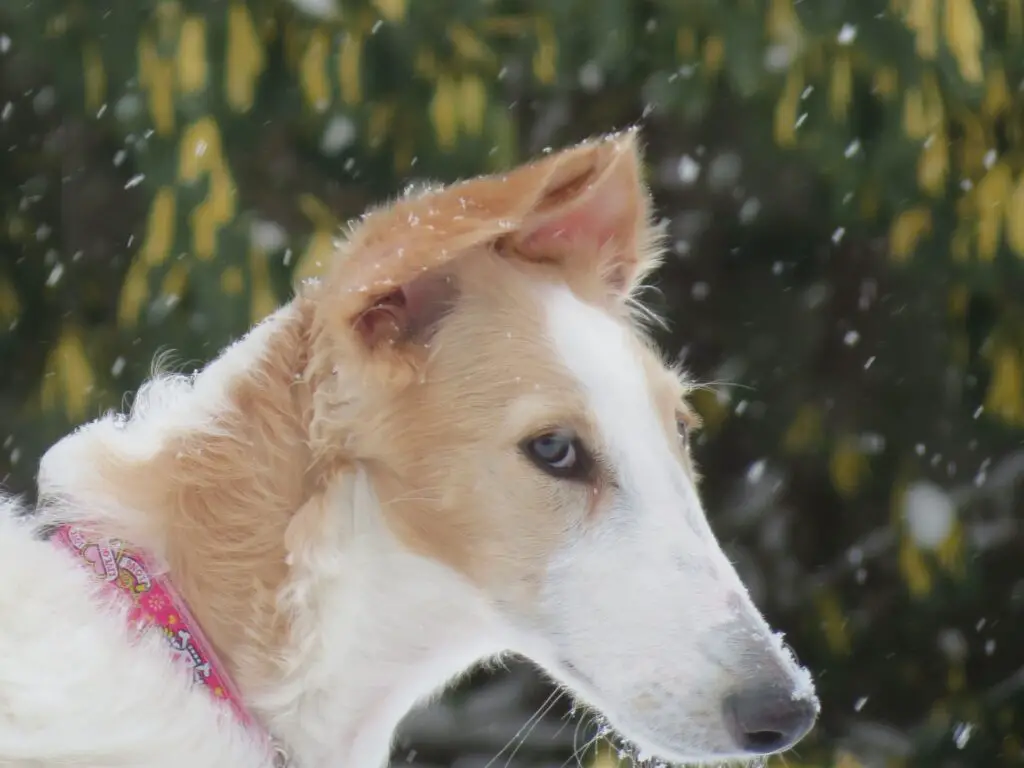Vizslas are sweet, energetic dogs originally bred to assist Russian conquerors. The breed continued to develop in Hungary and was used for hunting small game such as hare, waterfowl, and other birds.
Like the Borzoi, these fierce hunters are lithe and agile with deep chests. They have shorter snouts, however, and aren’t sighthounds—instead hunting primarily by scent.
Table of contents
- Borzoi vs Vizsla
- Borzoi vs Vizsla Appearance
- Borzoi vs Vizsla Temperament
- Borzoi vs Vizsla Exercise
- Borzoi vs Vizsla Grooming
- Do Vizlsas Shed?
- Are Vizslas Hypoallergenic?
- Are Vizslas Good Family Dogs?
- How To Pronounce Vizslas
- How Much Do Vizsla Puppies Sleep?
- How To Keep a Vizsla Busy
- Why Do Vizslas Shake?
- Are Vizslas Good with Cats?
- Do Vizslas Like to Cuddle?
- Can Vizslas be Left Alone?
Vizslas have also worked closely with humans throughout their history, making them easier to train and more eager to please than Borzois.
In this article, we’ll discuss these two breeds, their similarities and differences, and more fun facts about Vizslas!
Borzoi vs Vizsla
The Vizsla is a hunting dog used to hunt small prey such as birds and hares. They can hunt on land and in the water.
Unlike the Borzoi, they are hyperactive, clingy, and eager to please. These dogs hunted alongside humans at all times and were bred for obedience rather than independence.
They are much more resilient in exercise and need more activity because of this. They’re also incredibly intelligent and need mental stimulation in the form of training and games.
Here is a quick rundown of each breed’s key features:
| Borzoi | Vizsla | |
| Lifespan | 9-14 years | 9-14 years |
| Energy Level | High | High |
| Grooming Needs | High | Low |
| Trainability | Intermediate | Easy |
| Size | Giant | Large |
Borzoi vs Vizsla Appearance
Borzois and Vizslas are similar in build, with long legs and deep chests. Borzois have longer, dolichocephalic muzzles, while Vizslas have a moderate snout length.
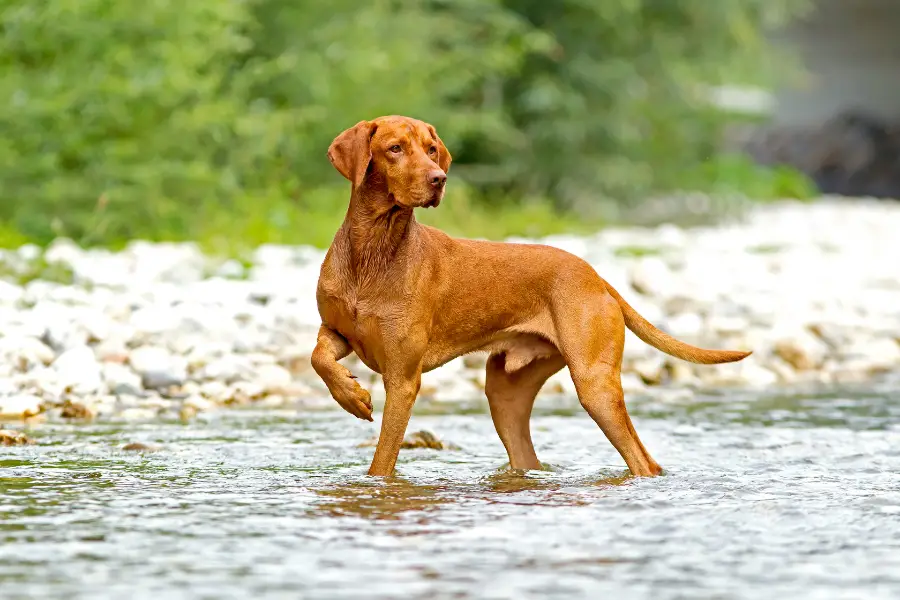
Vizslas are bred in various colors ranging from golden, rust, and red. They may have white markings. Their coats are short in length with no undercoat.
Borzoi coats are more diverse, displaying colors across the spectrum including black, tan, white, and red. They might have a variety of markings, and have long, straight double coats.
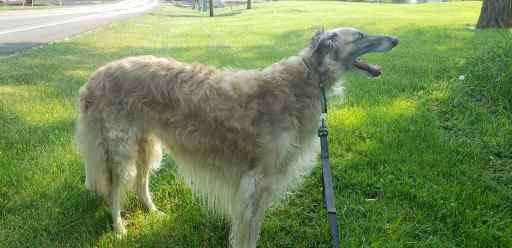
Vizslas are large dogs but will look small next to the giant Borzoi. While Borzois measure 26 inches and up, Vizslas stand 21-24 inches tall.
Borzoi vs Vizsla Temperament
Vizslas are a lot easier to train than your typical Borzoi. They have the same intelligence and prey drive, but they’re also incredibly eager to please.
They were bred to work much more closely with humans during the hunt, which makes them family-loving and sometimes clingy. It’s important to teach them to be alone by providing positive experiences when they’re young.
With smart dogs like these, it’s crucial to train them well. Use positive reinforcement methods for both breeds. These are sensitive dogs that will be even more harmed by harsh training methods than your standard breed.
Vizslas are less stand-offish and more accepting of strangers than Borzois, but they can also be timid without proper socialization. Introduce them to a variety of experiences early in life to help them gain confidence.
This breed is clingier than the Borzoi and might be the better option for those with children or other dogs. Vizslas can also be good with cats but, like Borzois, they need to be raised with them and introduced with caution.
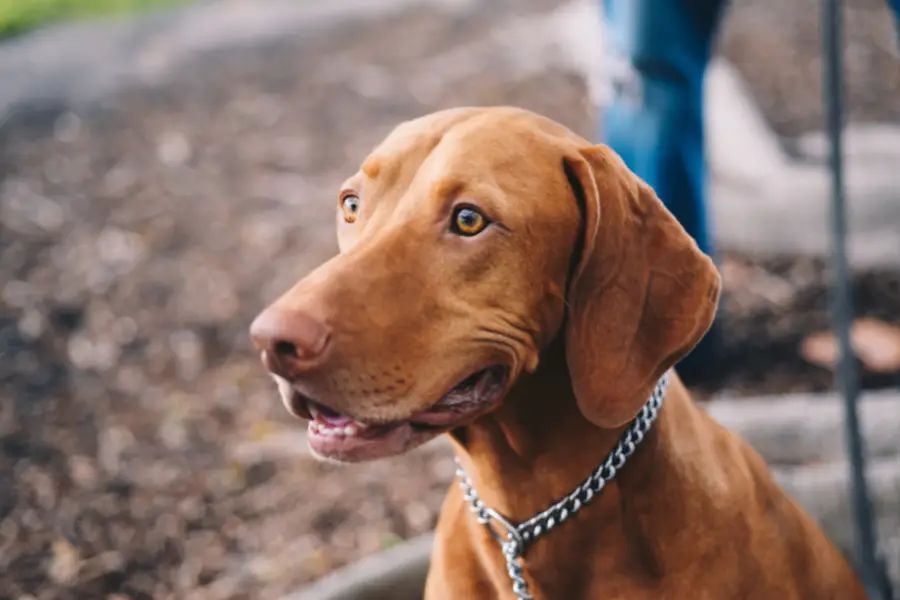
Borzoi vs Vizsla Exercise
Both dogs require long, daily walks and large yards to exercise in. Vizslas are much more hyperactive, especially while young, and typically don’t outgrow their puppy years until they’re 2-3 years old.
While Borzois are ready to lounge around the house after a good sprint, Vizslas may seem like they’re always ready to go!
If you want a laid-back companion, Borzois are your best friends, but if you want an exercise buddy with high endurance, Vizslas are a great fit!
Just make sure not to over-exercise them during puppyhood.
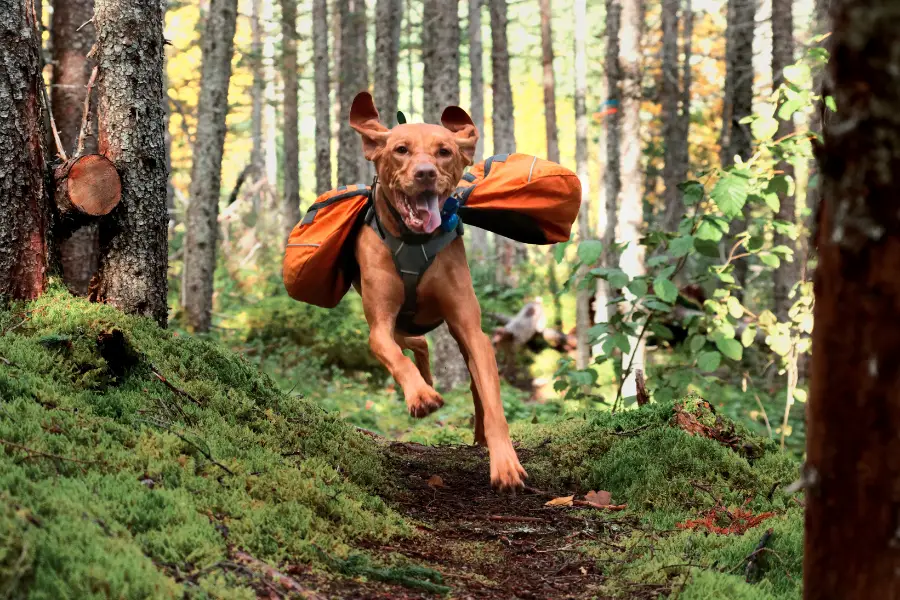
Borzoi vs Vizsla Grooming
These dogs could hardly be more opposite in the grooming department. While Borzois have long coats that require constant grooming, Vizslas are low-maintenance.
Brush their short coats weekly to lessen shed fur around your home and to keep their coats healthy and sleek.
Both dogs will need their teeth brushed, ears cleaned, and nails trimmed regularly.
Do Vizlsas Shed?
Vizslas shed moderately. They don’t have an undercoat, which allows you to avoid big shedding seasons throughout the year, but they’ll still leave fur on your sofa, clothes, and floors.
The best way to keep up with this is to brush them once or twice weekly. Vacuum regularly to pick up any stray hairs, keep a lint roller on hand, and you should be good to go!
Are Vizslas Hypoallergenic?
Vizslas are not hypoallergenic. Hypoallergenic breeds tend to have long, human-like hair rather than fur, which is what makes them so much better for those with dog allergies.
It’s typically a dog’s dander, rather than their fur, that humans are allergic to. Dogs with hair, rather than fur, shed less. This leads to less dander as well.
Vizslas have a short, fur coat that sheds and will set off your allergies if you’re allergic to dogs.
Are Vizslas Good Family Dogs?
Yes! Unlike Borzois, who can be stand-offish and take some time to warm up, Vizslas were bred to interact closely with people. Having a family is even better with these dogs since they don’t like being left alone for long periods.
That said, it’s important to socialize your Vizsla well, which includes teaching them to be alone without fear or panic. This breed can easily develop separation anxiety.
These dogs are incredibly friendly, typically great with children, and may be downright clingy! Don’t adopt a Vizsla if you don’t want a pal constantly by your side.
Although Vizslas are a great breed for families, you’ll still want to supervise children around any dog. Large breeds especially can hurt kids, even if by mistake while playing too roughly. Children might also injure dogs if they aren’t taught to interact gently.
How To Pronounce Vizslas
The combination of the letters “z” and “s” in this way is something we rarely see in American English, which can make the pronunciation of Vizslas confusing!
How do you say Vizslas?
- Veez-luhs
Vizslas is the plural of Vizsla, which is pronounced veez-luh.
How Much Do Vizsla Puppies Sleep?
With their boundless energy, it may seem as though Vizsla puppies never sleep! Tired puppy parents might ask when they’ll finally go down for a nap!
Not to worry: like most puppies, Vizslas sleep 18-20 hours a day. It’s just that when they’re awake, they’re rearing to go.
Some Vizsla puppies need over two hours of activity every single day. However, you do want to make sure not to over-exercise these dogs. Puppies aren’t yet ready for long hikes or runs, but are better off with short bursts of activity throughout the day.
Playing at home will be good for this since your puppy will have their bed or the couch nearby if they’re ready to crash after a game of fetch!
How To Keep a Vizsla Busy
This breed is active and versatile, which means you can have a ton of fun with them! Active people will have a blast with a Vizsla and can always find new activities to enjoy with their pup.
Adult dogs need long, daily walks or runs. A large, enclosed yard is also a must so that your dog can run around when they need to.
This may not seem like enough for these energetic dogs, however. If your Vizsla seems bored, here are some ways to keep them busy:
Playing Games in the Yard
It’s often not enough to let your Vizsla into the backyard alone since these social dogs want somebody to play with. Simple activities include tossing a ball or flying disk for them to fetch. This will stimulate hunting and engage your dog’s instincts!
For added fun in the summer months, try tossing a ball into a shallow kid’s pool. This will allow your Vizsla to cool off and the pool will further engage their instincts for hunting waterfowl.
Get that nose working by hiding some yummy treats for your Vizsla to track. This is easier when done indoors, but outside play can add an extra challenge as it comes with more scent distractions.
Once your Vizsla can reliably track treats, try hiding other things like toys or play a game of hide-and-seek with the family.
Socializing at the Dog Park
This breed tends to be very dog-friendly, and your pup might benefit from some doggy friends. Once your puppy has all of their vaccines and is spayed or neutered, bring them to the dog park to play and interact.
Dog parks are also great places for your dog to run since they are large and enclosed. Your Vizsla will surely enjoy all the new scents, even if there’s no one else at the park currently.
Bring along some toys for them to play with for extra fun!
Of course, you should always introduce dogs carefully. You never know how they’ll interact with one another, and sometimes very animal-friendly dogs will decide there’s one dog they dislike for some reason.
Don’t let this discourage you from trying, though. The earlier you socialize your Vizsla with other dogs, the better off they’ll be.
Using Puzzle Feeders
Puzzle feeders are excellent for intelligent dogs like the Vizsla. They’ll appreciate playing games and working for their food.
These toys also slow their eating, which is important for deep-chested breeds and can help to avoid bloat—a deadly condition where the stomach fills with air and flips inside the body.
There are many ways to engage your Vizslas mind, but alternating puzzle toys throughout the week is one of the easiest.
Participate in Dog Sports
Vizslas are well-suited to several sports including agility, lure coursing, and dock diving. There’s no end to the fun you can have with them!
Even if you don’t want to participate in organized sports with your dog, teaching the foundations of agility or setting up a lure for your dog to chase in your own backyard provides plenty of activity and mental stimulation for your pup.
Be creative and have fun with it!
It’ll also be worth looking up the suggested age for these activities before trying them if your dog is still young. For instance, high jumps and long runs aren’t recommended for puppies under two years old.
Keep up with their Training
Basic training is important and essential, but there’s no end to the things you can teach your Vizsla. Keeping up with their training, whether they’re learning new tricks like agility or practicing their basic commands, stimulates their brains and keeps them occupied.
If your Vizsla is feeling very hyper, now isn’t the time to train. Choose another activity, then come back to training when your dog is feeling less energetic.
They shouldn’t be ready to sleep, but they also shouldn’t be bouncing off the walls!
This will get you the best results and stop you and your dog from becoming frustrated. Remember that training is meant to be fun for you both, and should end on a high note whenever possible.
Why Do Vizslas Shake?
If your Vizsla is shaking, know that this is fairly normal for the breed. They get cold, nervous, and hyper easily.
Even in fairly warm temperatures, Vizslas tend to get cold and shiver. Some people report their Vizslas shaking in temperatures below 70 degrees Fahrenheit, typically when they’re not active—with active Vizslas not reacting as much, likely because they’re keeping warm by running around.
Sweaters or blankets can help, as well as keeping the heat on inside in the winter.
Puppies may get nervous when brought home for the first time or experiencing anything new. Separation anxiety can also cause your dog to shake when you’re about to leave home. It’s crucial to teach your Vizsla that being alone is okay!
Hyper dogs might also shake as a way of releasing excess energy. Make sure your pup is getting enough daily exercise, but don’t wind them up too much—they need plenty of sleep, too!
If your dog is constantly trembling or you can’t find an explanation for their shakes, make an appointment with your veterinarian.
Are Vizslas Good with Cats?
One big drawback to Borzois is their inability, often, to get along with small dogs and cats. You may wonder, do Vizslas get along with cats better?
The answer is typically yes, although every dog is different. Vizslas raised with cats do best with them and tend to be gentle. However, some Vizslas may still see cats as prey or enjoy chasing them around, which is too stressful for a cat.
When adopting a new Vizsla, ask about their history, including whether or not they’ve been around other animals. Some organizations test their dogs with other dogs and cats for reactivity, which is a great idea before bringing a dog into your multi-pet home.
Do Vizslas Like to Cuddle?
Every dog is an individual, but most Vizslas will love to cuddle up with their favorite humans! They love to be close to their family and can be extremely clingy, thinking themselves lap dogs despite their large size.
People who love affection and don’t mind a big dog sitting atop them will love this breed, while others might find them too overbearing.
Of course, your Vizsla can be trained to cuddle appropriately—sitting beside you rather than right down on your chest, for instance.
However, you should always keep their emotional needs in mind. Ensure you have plenty of time to spend with your Vizsla and won’t mind their snuggly nature before you adopt!
Can Vizslas be Left Alone?
Vizslas can be left alone for short periods of time, but never more than six hours at a time. Like all dogs, they aren’t suitable for those who work long hours.
It’s best if you live with other people who can keep your Vizsla company throughout the day. You can also ask someone to stop by in the middle of your workday, or hire a dog sitter or dog walker.
Keep in mind that this is a clingy breed, prone to separation anxiety. You don’t want them to be alone so much that they feel neglected. However, you don’t want to coddle them too much either!
Teaching your Vizsla how to be alone is crucial and should begin the moment you adopt them, no matter their age.
Here’s how to accommodate your Vizsla to being left alone:
- Start slowly. You might only be able to leave the room for a few minutes at first, and this is okay!
- Entertain your Vizsla. Put them in a room with their dinner and leave, or give them a chew toy—ideally, they won’t even notice you’re gone at first.
- Reward good behavior. Grab some tasty treats and reward your Vizsla when they do well with you being away. They shouldn’t be barking, chewing destructively, or trying to escape confinement.
- Don’t punish them. Punishments for dogs don’t work and will harm your relationship with your sensitive Vizsla. If your dog is responding poorly to being left alone, try shorter periods and better distractions.
- Increase the time and distance away. You might start with leaving the room for two minutes while your dog eats, then stay out of the room for ten minutes, and so on, until you eventually work your way to going to the grocery store for an hour.
- Have patience and go at their pace. It’s important that these experiences are positive so that your dog learns that being alone isn’t scary, and you’ll always be back. You may be tempted to rush the process, but it’ll only lead to fear from your dog, which will lengthen your training time in the end.
Training your Vizsla to be alone will help to prevent separation anxiety and ensure your dog feels secure while you’re away.
Even if you’re at home most of the day or there’s always someone with your dog, it’s important that they learn and practice this skill.
You Might also Like:
Eventually, they’ll end up home alone or having to stay at the veterinarian, and you want them to feel comfortable and confident when the time comes!

